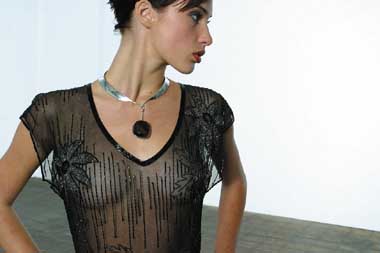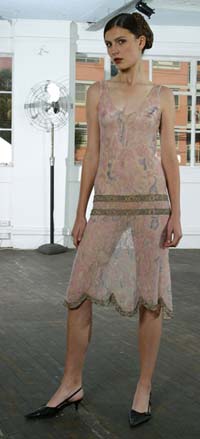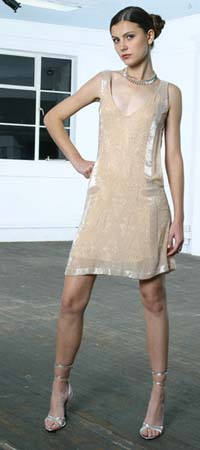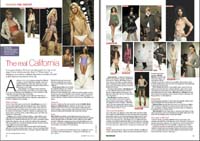|

HE WORDS fashion, social
conscience and environmental sustainability are not often
seen in the same sentence but for Australian designer Gabriel Scarvelli,
it is the way forward for fashion and the future.
Wherever possible, Scarvelli uses natural fibres,
98 per cent of the dyes he uses to colour his fabrics are organic,
he rescues rose quartz chips destined for the scrap heap to bead
onto his garments, employs 12 Indian beadworkers in a small factory
two hours out of Calcutta whom he pays 48 times the average wage,
and plans to help them set up an independent organic cotton plantation.
All this aside, Scarvelli, 25, has talent—lots of it.
At Mercedes Australian Fashion Week in May 2003,
he launched his first signature collection of intricately beaded
dresses now stocked at luxury boutiques Tracey Ross on Sunset Boulevard,
Coco Ribbon in Notting Hill, Karen Walker in New Zealand and a number
of high-profile fashion boutiques throughout Australia.
His most recent show at MAFW
’04 at the Cove, Sydney was a triumph and hailed one of two fashion
moments of the week—the other belonging to couture jewellery designer
Sarina Suriano (see separate report).
Inspired by Sydney’s gangster women of the 1930s,
Scarvelli named his collection Razor, after the Razor Gang
who used to rule the streets of Surry Hills where his workroom is
based.
This time it was Scarvelli’s turn to rule. Trebling
the number of pieces of his hand-finished demi couture from eight
to thirty-eight beaded styles, models sashayed down the runway wearing
fabulous flapper frocks fashioned from silk georgette, hand-embroidered
tulles and French lace.
However, unlike many young fashion designers Scarvelli
has not let his success go to his head.
‘My goal is not to be rich and famous. My aim
in life is to help people out because someone once helped me,’ Scarvelli
said.
His passion and drive for protecting the planet
and helping the underdog can be explained in part by his story,
which reads like a Charles Dickens novel featuring a guest appearance
by Cinderella’s fairy godmother.
Growing up in a dysfunctional home, Scarvelli
had a less than happy childhood and found solace in his aunt’s vintage
clothing shop in Paddington where he helped mend garments for $2
an hour.
One day, a 90-year-old Russian woman walked into
the store. Upon seeing some of the beaded garments, she revealed
that she used to work for haute couture beading and embroidery institution
House of Lesage in Paris.
She announced she would teach Scarvelli, then
aged 12, the secrets of tambour, the French beading and embroidery
method, even though she had signed a confidentiality agreement in
1925 never to pass on the skills. She died a year later leaving
him all her equipment.
Two years later, home life, coloured by alcohol
and abuse, became too much. He ran away aged 15 with ‘nothing but
the clothes he was wearing, a bag and a book’.
He lived on the streets of Sydney for several
months, one day passing out from lack of food and woke up in hospital.
Doctors quickly diagnosed he had the beginnings
of liver cancer. He was operated on ‘as a ward of the state’, had
part of his liver removed and told he had a 10 per cent survival rate.
‘I made a decision that if I woke up from the
operation I was going to get out of the situation I had been in,’
he said.
‘I was being given a second opportunity at life
and that was my inspiration.’
In the beginning, no one wanted to employ him
because he didn’t have a second change of clothing, but he persevered
working any job he could get in a cutting room.
It wasn’t long before he was snapped up by designer
Collette Dinnigan after he began beading for the bridal industry
and worked for her for three years as head beader.
While working for Dinnigan he was exposed to beaded
fabrics from India, many of which were badly made.
‘They knew how to bead but didn’t know how to
knot it off properly,’ he said.
However, the work inspired him to make his first
trip overseas, at age 19, to Calcutta, India with the view of working
with and paying bead workers to create beautiful fabrics for a growing
list of clients that included Jodhi Packer and Peter Morrissey.
‘The travel agent asked me where in India I wanted
to go. I looked at the map and the first city I saw was Calcutta.
I said, "Calcutta," and the agent looked at me as if I
was an alien and said, "Are you sure?" I said, "Yes,
I will stick with my first gut feeling and go to Calcutta",’
he recalled.
With a budget of A$1,000, Scarvelli gave himself
two weeks to find a factory to bead for him. He found it on the
second day, two hours out of the city. It is the same one of which
he is now a part-owner and still uses today.
It turned out that at one time the factory had
beaded for Christian Lacroix and had only reopened months earlier,
after being closed for 10 years.
The factory had lost many of its skilled workers,
so Scarvelli sat on the floor with them for a week and began teaching
them what he knew. A special bond and friendship were born.
Over the past six years he worked with the people
of the village, the name of which he will not disclose, and helped
set up a co-op system and successful beading operation.

CONTINUED

|
 

  |
 |
Download more of this
story as laid out in Lucire August 2004: click
here for download page or above for the PDF of the
'Scene' section  |
| Your feedback wanted: click
here to participate in the Lucire chat |
|
‘The travel agent asked
me where in India I wanted to go. I looked at the map and the first
city I saw was Calcutta. I said, “Calcutta,” and the agent
looked at me as if I was an alien and said, “Are you sure?”’
|


